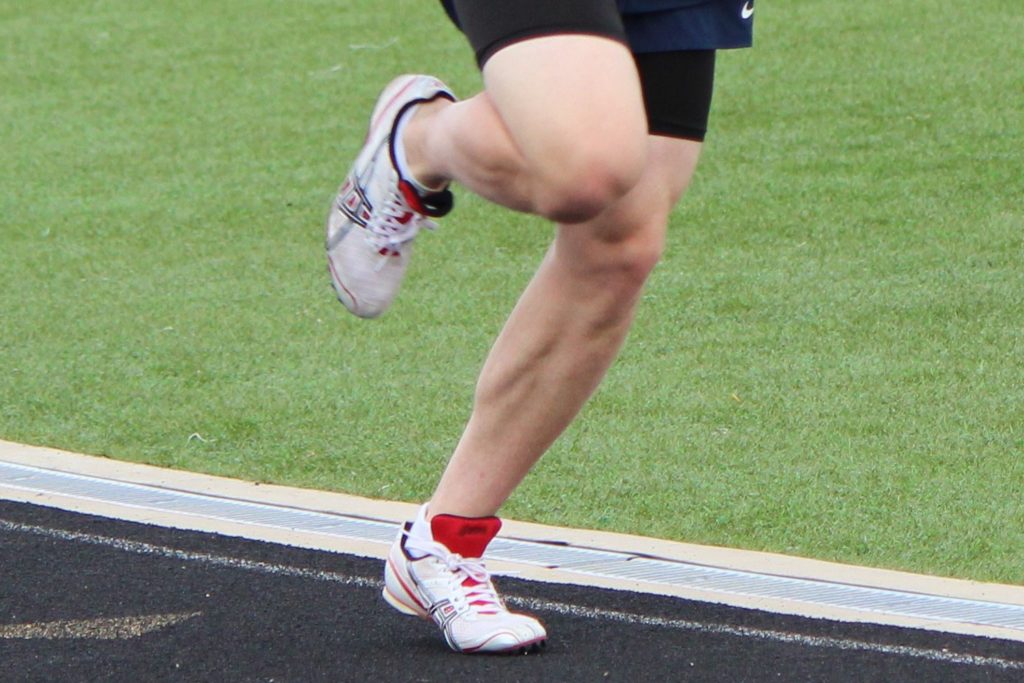
 By Kate Zanoni, LPTA
By Kate Zanoni, LPTA
Wellness Blog Contributor
[twitter-follow screen_name=’@toCME4PT’]
(February 24, 2016) — For athletes or those starting an exercise program, doing too much too soon can result in a painful and potentially side-lining injury: shin splints!
So what are they and how can you prevent them? Shin splints are an overuse injury caused by repetitive stress to the lower legs.
Runners who increase their intensity or incline too soon or those who don’t have a good stretching program are at risk for shin splints. It’s also very common for athletes to get shin splints at the start of a sports season when they haven’t had proper training in the offseason; we have seen this increase over the last several years with many athletes in Loudoun County playing on turf fields.

When a runner or an athlete doesn’t train properly for their sport, they can lack the strength, muscle length and endurance needed for peak performance. With weakness and tight muscles, we see muscle imbalance which increases the risk for shin splints and other injuries. Dancers are also very prone to shin splints – repetitive movements in their routines without cross-training puts them at high risk.
Have you ever felt pain in your shins after your first practices at the start of a sports season or new running program? If you’re a dancer who is practicing the same routine over and over you may also have felt pain or burning along the front of your shin after a long class.
Starting a high intensity exercise program that involves running, sprints or repetitive movements can cause undue stress to the muscles and connective tissue along the shin leading to pain or burning on the inside or outside of the front of your shin. Shin splints can also occur if you suddenly change your workout regimen, such as switching surfaces from pavement to clay to grass to turf; differing intensities on the dance floor, court or field; or running on uneven surfaces such as up or down hills on trails or hard surfaces.
When an unconditioned athlete starts to train too hard, or if an experienced athlete changes his or her training intensity or type of surface, the shin bone (tibia), muscles and tissues in the area can become overloaded, leading to inflammation and pain.

Shin splints usually occur from an imbalance between the calf muscles and the muscles in the front of your leg, although additional muscles in the lower leg may also be affected. These muscles play a large role in all of the movement patterns of your lower leg and foot.
Although shin splints can occur on both legs, it’s more common for the dominant leg to be affected over the other due to overuse and associated compensation.
Shin splints occur as a result of micro tears where the shin muscles and connective tissue attach to the bone along the shin resulting in pain and inflammation. If left untreated, shin splints can lead to a stress fracture which will require long term rest and may result in your missing the remainder of your sports season, having to halt your training regimen or missing an important dance performance or competition.
When you return to your sport, remember to reintroduce your activity incrementally to avoid doing too much, too soon. When returning to running, increase your mileage no more than 10-percent per week to allow your muscles and joints to adjust to the increased stress.
Other factors that can contribute to shin splints:
- Inadequate and infrequent stretching
- Lack of arch support
- Worn out shoes
- Excessive stress placed on one leg over the other from running in the same direction on a track or on pitched roads
How to prevent shin splints
- Stretch – this is an excellent way to prevent shin splints before they happen!
- To stretch your largest calf muscle (gastrocnemius): begin in a staggered stance position with one foot in front of the other. Keeping your back heel down, lunge forward by slightly bending your front knee. You should feel a stretch in the back of your calf in the back leg. Hold for 20-30 seconds and repeat 3 times for 2-3 times per day.

To stretch your largest calf muscle… - To stretch your smaller calf muscle (soleus): begin in a staggered stance position with one foot in front of the other. Lunge forward by slightly bending your front knee. To isolate the soleus muscle, slightly bend your back knee, but keep your heel on the ground to maximize the stretch. Hold for 20-30 seconds and repeat 3 times for 2-3 times per day.

To stretch your smaller calf muscle… - To stretch the front part of your shin: begin in a slightly staggered stance with one foot slightly in front of the other. With your back foot, point your toes toward the floor and slightly inward, then gently press your foot into the floor until your feel a stretch in the front of your shin. Hold the stretch for 20-30 seconds and repeat 3 times for 2-3 times per day.

To stretch the front part of your shin…
- To stretch your largest calf muscle (gastrocnemius): begin in a staggered stance position with one foot in front of the other. Keeping your back heel down, lunge forward by slightly bending your front knee. You should feel a stretch in the back of your calf in the back leg. Hold for 20-30 seconds and repeat 3 times for 2-3 times per day.
- Strengthen your core and supporting muscles – this helps to prevent compensating movements and increases performance
- Cross-Train – in the offseason you should be participating in a cross-training program to strengthen all supporting muscles and prevent overuse injuries.
How to treat shin splints
- Ice – Ice your affected shin for 10-15 minutes, 3-4 times per day to reduce the acute inflammation and ease the pain.
- Stretching
- Progressive strengthening
- Rest – Depending on the severity and duration of the pain, it can take days to several weeks of rest to decrease the inflammation in the area.
- Physical Therapy – The sooner you get care, the faster you will heal. A physical therapist is an expert at evaluating your strength, range of motion and determining the cause of your injury. They will work with you to develop a treatment and training program specific to your needs and get you back to doing what you love quickly. Finding a therapy practice that offers return to sport programs will help prevent future injury related to repetitive or overuse.
Note from our sponsor: At Loudoun Sports Therapy Center, our expert physical therapists will conduct a personalized evaluation to determine the cause of your pain and get you back to peak performance quickly. Call LSTC today at 703-450-4300 or check out their website: www.loudounsportstherapy.com.
Once you have completed your therapy, we offer return to sport training programs with our Certified Athletic Trainers to ensure you get back to doing what you love.




